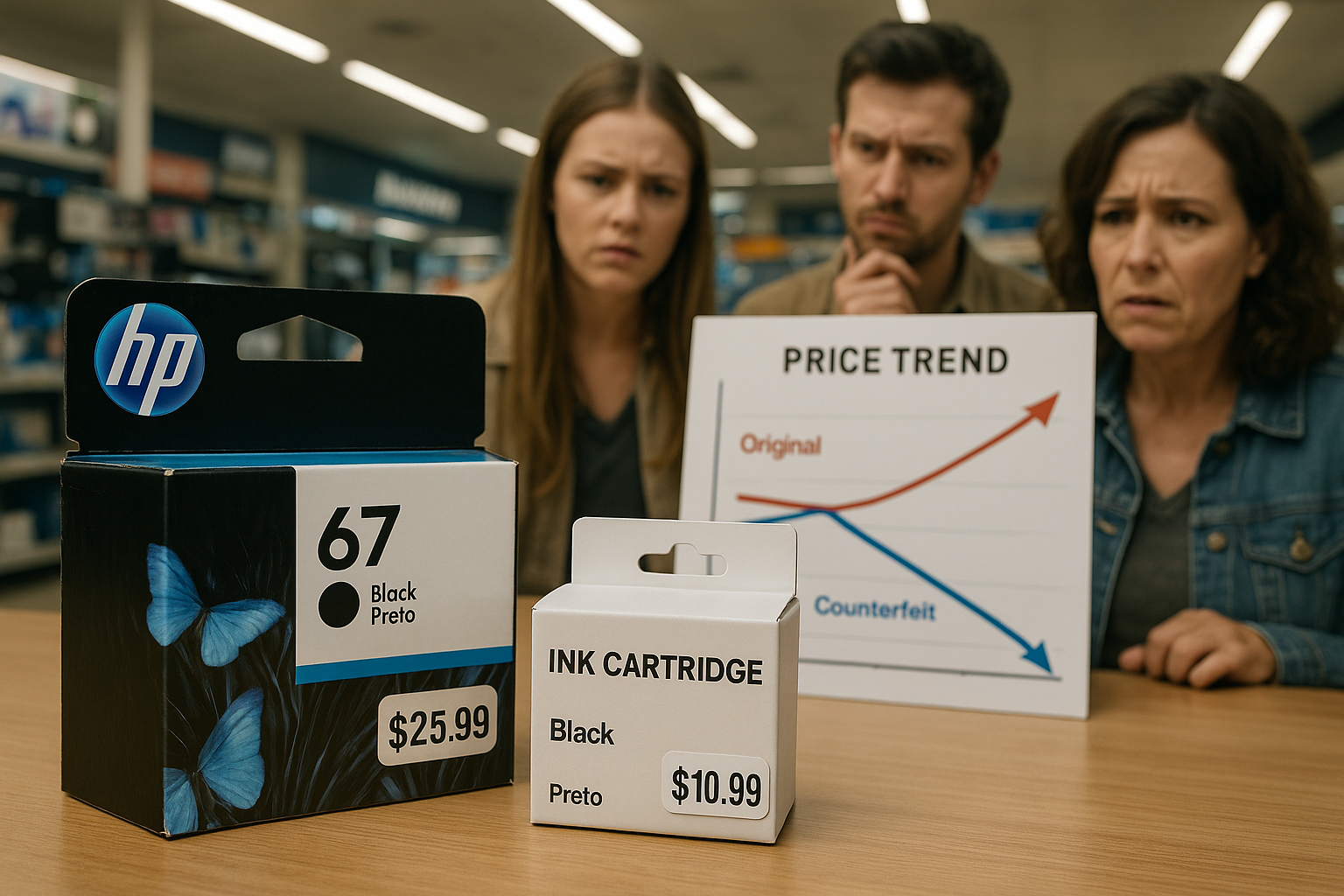In an era where technology continues to revolutionize industries and shape markets, there are hidden currents that stealthily impact economic trends and consumer behavior. One such covert factor is the proliferation of counterfeit products, particularly in the niche of cartridges used in printers and similar digital devices. The phenomenon of fake cartridges has emerged as a significant force in the market, affecting price trends and posing a myriad of challenges for manufacturers, retailers, and consumers alike. This article, “Uncovering the Truth: How Fake Cartridges Are Impacting Price Trends in the Market,” is an in-depth exploration of this complex issue.
To appreciate the magnitude of the problem, one must first understand the cartridge market’s vastness. From the humble home office to vast corporate establishments, cartridges find their use in a myriad of applications. As the demand continues to rise, so does the opportunity for counterfeiters to exploit unsuspecting consumers. The arrival of these fake cartridges, often remarkably similar to their genuine counterparts, has created an uneven playing field. This situation has severe repercussions on market dynamics, and it is these impacts that we seek to scrutinize and understand in this article.
Let’s first explore the economic implications. The infiltration of fake cartridges into the market has sparked a heated price war. Since these counterfeit products are often cheaper than genuine cartridges, they can drive down market prices, forcing authentic manufacturers into a vicious cycle of cost-cutting and thinning profit margins. But the damage extends far beyond economics. The counterfeit cartridges are typically of inferior quality, leading to compromised performance, frequent breakdowns, and a host of other technical issues. These problems cost consumers in terms of time, money, and productivity, and can even result in irreparable damage to their devices.
In the following sections of this article, we will delve deeper into these issues. We will examine how counterfeit cartridges are manufactured and distributed, the legal and ethical implications of this illicit trade, and the strategies employed by original manufacturers and authorities to combat this menace. We will also highlight the role of consumers and retailers in perpetuating this problem, often unknowingly, and discuss potential solutions and preventive measures.
By shedding light on these critical aspects, we aim to offer a comprehensive understanding of how fake cartridges are affecting the market and what can be done to mitigate their impacts. Knowledge is power, and we believe that by equipping our readers with the right information, we can contribute to creating a more informed and vigilant consumer base. This in turn can disrupt the counterfeit market, stabilize price trends, and lead to a more robust and fair marketplace. As we embark on this enlightening journey, let’s bear in mind that every cartridge matters and that the choices we make can have far-reaching consequences. So, buckle up and join us as we unravel the hidden truths of the cartridge market.
The Alarming Presence of Fake Cartridges in the Market
As consumers, we are often driven by two main factors while making our purchases: price and quality. However, in the quest for affordable products, the market has seen a considerable increase in counterfeit goods, specifically within the realm of ink and toner cartridges. These fake cartridges, while initially appearing cheaper, can end up costing more in the long run, impacting not only the consumer but also the broader market dynamics.
Fake cartridges are typically manufactured by unauthorized third parties, designed to mimic the appearance and performance of original cartridges from established brands. They are usually sold at a fraction of the price, making them attractive to budget-conscious consumers. However, the low upfront cost of these cartridges masks the potential financial and performance pitfalls that may arise with their use.
The problem of fake cartridges is widespread and growing. A report from The Imaging Supplies Coalition for International Intellectual Property Protection (ISC) estimated that counterfeit imaging supplies caused a loss of $3.5 billion in the industry worldwide in 2018 alone. The impact extends beyond just monetary losses; the proliferation of fake cartridges also undermines consumer trust in brands and the integrity of the market.
Fake Cartridges Vs. Genuine Cartridges: A Comparative Analysis
To understand the real impact of fake cartridges on the market, it’s necessary to compare them with their genuine counterparts. In the table below, we examine the key differences between fake and genuine cartridges in terms of quality, performance, cost, and environmental impact.
| Fake Cartridges | Genuine Cartridges | |
|---|---|---|
| Quality | Low-quality materials, inconsistent ink/toner quality | High-quality materials, consistent ink/toner quality |
| Performance | Poor print quality, frequent malfunctions | Excellent print quality, reliable performance |
| Cost | Low upfront cost, potentially high long-term costs (due to malfunctions, repairs) | Higher upfront cost, low long-term costs |
| Environmental Impact | High waste generation, non-compliant with environmental regulations | Designed for recycling, compliant with environmental regulations |
The comparison above clearly shows that while fake cartridges may seem attractive due to their low upfront cost, they are likely to result in poor performance, potential damage to printing equipment, and a greater environmental impact.
The Price Trends: The Impact of Fake Cartridges
One of the most significant impacts of the presence of fake cartridges in the market is on price trends. The proliferation of counterfeit cartridges creates an artificial price war, forcing genuine manufacturers to reduce their prices to compete. However, this can lead to a reduction in quality as brands may be compelled to cut costs to offer competitive prices.
Simultaneously, the widespread availability of counterfeit cartridges can influence consumers’ perception of what constitutes a ‘fair’ price for these products. This can lead to an undervaluation of genuine cartridges, undermining their market position. Moreover, the financial losses incurred by brands due to counterfeiting can impede their ability to invest in research and development, stifling innovation in the industry.
While consumers might believe they are saving money by purchasing cheaper, counterfeit cartridges, the reality is that these savings are often offset by the lower quality and performance of these products. The video below from the YouTube channel “Printerland Review” titled “Genuine Vs. Compatible Toner” provides a detailed comparison of genuine and compatible toner cartridges, highlighting the potential pitfalls of opting for cheaper alternatives.
How to Identify and Avoid Fake Cartridges
Given the negative impact of fake cartridges, it’s crucial for consumers to be able to identify and avoid them. Here are a few tips:
- Price: If the price seems too good to be true, it probably is. Genuine cartridges are more expensive due to the quality of materials and the research and development that goes into their production.
- Packaging: Counterfeit cartridges often have substandard packaging. Look for signs of poor-quality print or materials, misspelled words, or missing holograms or logos.
- Buy from reputable sources: Always purchase from authorized retailers or directly from the manufacturer. Be wary of online marketplaces that may sell counterfeit products.
By being vigilant and making informed decisions, consumers can play a crucial role in mitigating the impact of fake cartridges on the market. It’s essential to understand that while counterfeit cartridges may seem cost-effective initially, their poor performance, potential to damage printing equipment, and environmental impact make them a costlier choice in the long run.

Conclusion
In conclusion, the increasing infiltration of counterfeit cartridges into the market presents a multi-faceted problem that impacts consumers, manufacturers, and the industry as a whole. Despite their initially appealing low cost, fake cartridges can end up being more expensive in the long run due to their poor performance, frequent malfunctions, and potential to damage printing equipment. Moreover, their manufacture and disposal often flout environmental regulations, leading to greater waste generation and environmental impact.
A comparative analysis between fake and genuine cartridges clearly illustrates the stark contrast in their quality, performance, cost, and environmental impact. Genuine cartridges, manufactured using high-quality materials and advanced technology, offer excellent print quality and reliable performance, while their counterfeit counterparts often fall short. Although genuine cartridges come with a higher upfront cost, their superior performance and durability can result in lower long-term costs.
The counterfeit cartridge industry also has a significant effect on price trends, fostering an artificial price war that can impact the quality of products and the market’s overall health. This artificial price competition can lead to an undervaluation of genuine cartridges and restrict brands’ ability to invest in research and development, thus stifling innovation.
However, consumers are not helpless in this situation. By being discerning and informed in their purchases, they can avoid counterfeit products and support genuine manufacturers. Checking for suspiciously low prices, poor quality packaging, and ensuring purchases are made from reputable sources can help in identifying and avoiding fake cartridges.
It’s crucial to raise awareness about the detriments of counterfeit cartridges and the benefits of supporting original products. By choosing genuine cartridges, consumers are not only investing in better quality and performance but also contributing to the sustainability of the industry and the environment.
Remember, the real cost of counterfeit cartridges isn’t just financial; it’s also environmental, and potentially damaging to the integrity of your printing equipment. So, next time you’re in need of a cartridge, think twice before reaching for the cheaper counterfeit. It may cost less now, but it’s likely to cost you more in the future.
Feel free to share your thoughts and experiences in the comment section below. If you found this article insightful, consider sharing it with your network. After all, by spreading awareness, we can collectively combat the counterfeit cartridge industry, and create a more robust, fair, and environmentally-friendly market for all.
For further reading, please check out these active sources: The Imaging Supplies Coalition for International Intellectual Property Protection’s (ISC) report on the economic impact of counterfeit imaging supplies, and the Printerland Review video on YouTube comparing genuine and compatible toner cartridges.
References:
1. The Imaging Supplies Coalition for International Intellectual Property Protection (ISC). 2018. Economic Impact of Counterfeit Imaging Supplies.
2. Printerland Review. Genuine Vs. Compatible Toner. YouTube.



